Here is a visual travel guide to Guimarães, Portugal in 17 photos.
Nowadays, a small city in the north of the country, Guimarães was instrumental in the foundation of independent Portugal in the first half of the 12th century.
With a pretty historic centre where narrow streets and sunlit squares still follow their medieval outlines, the city is a beautiful blend of Gothic architecture and Baroque influences.
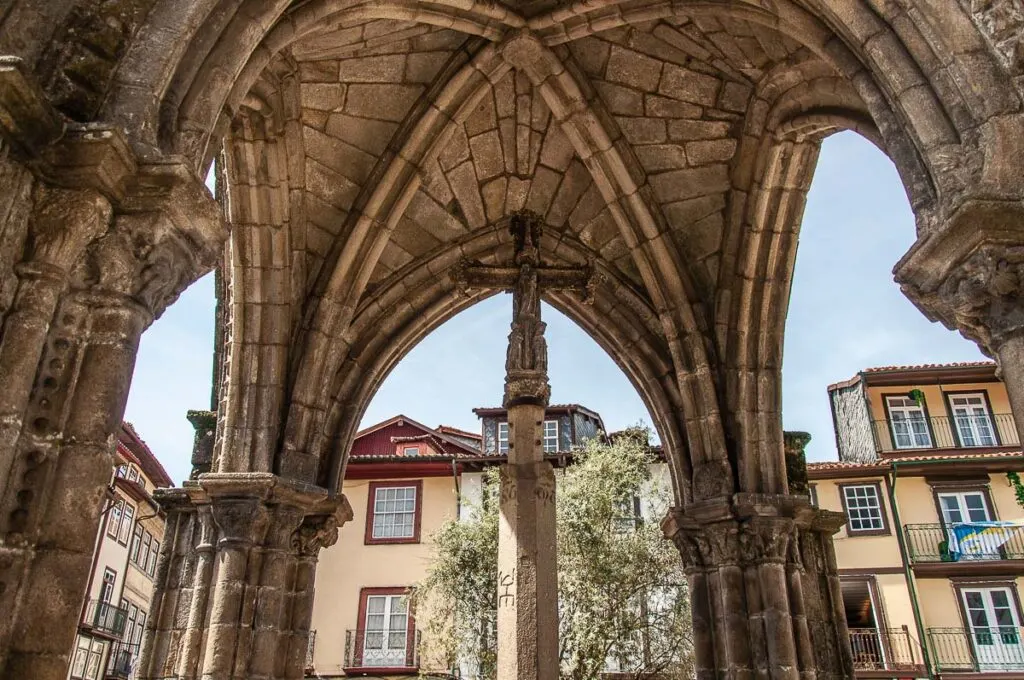
Visiting Guimarães is immersing yourself in Portuguese history and in the Portuguese national identity in the most authentic way. It’s not in vain that in the heart of the city a large sign proudly proclaims: ‘Portugal was born here!’.
And while the historic centre of Guimarães is a UNESCO World Heritage Site and ten short years ago it was Europe’s Capital of Culture, the city – small, compact, and so very easy to explore on foot – seems to stay firmly off the beaten track.
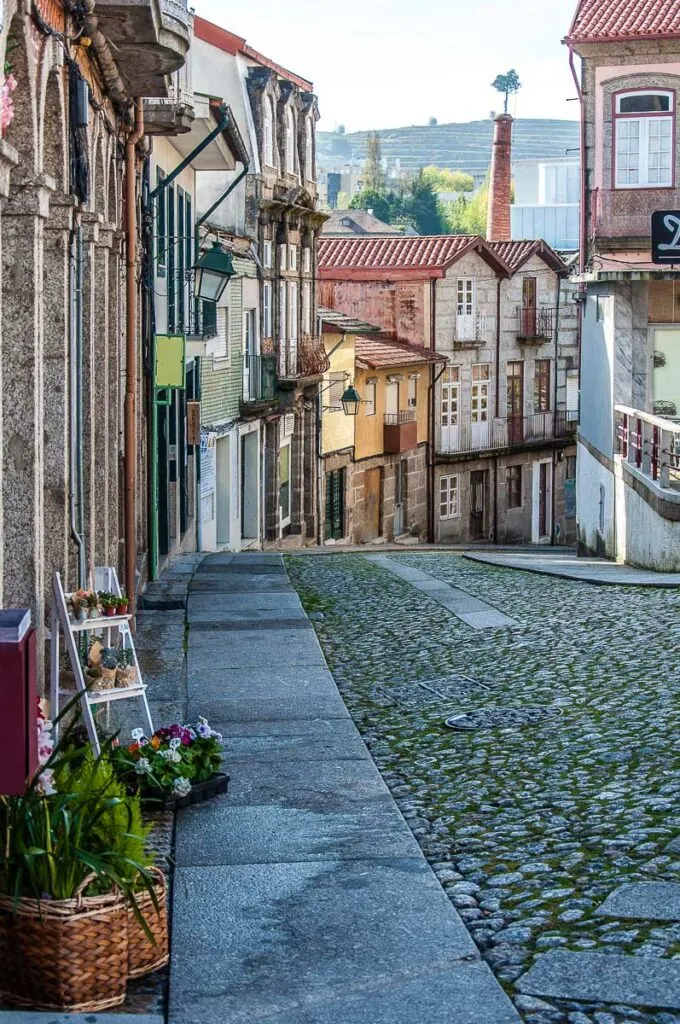
Easy to reach from Portugal’s second-largest city – Porto – Guimarães has so much to offer to the traveller seeking to experience history, good food, and nature in equal measures.
Dotted with churches, rich in azulejo-covered facades, and truly exuberant during the traditional local festivals and celebrations, the city also has its own pastries and sweets. To this day they are meticulously prepared by hand following ancient convent recipes which are a closely guarded secret.
Plus, Guimarães has a cable car. It takes you up a gentle slope to the top of the 613 m high Monte da Penha. This is where you can enjoy panoramic views of the city, visit a Catholic sanctuary with striking architecture, and then hike among large mossy boulders that create a fairytale-like landscape.
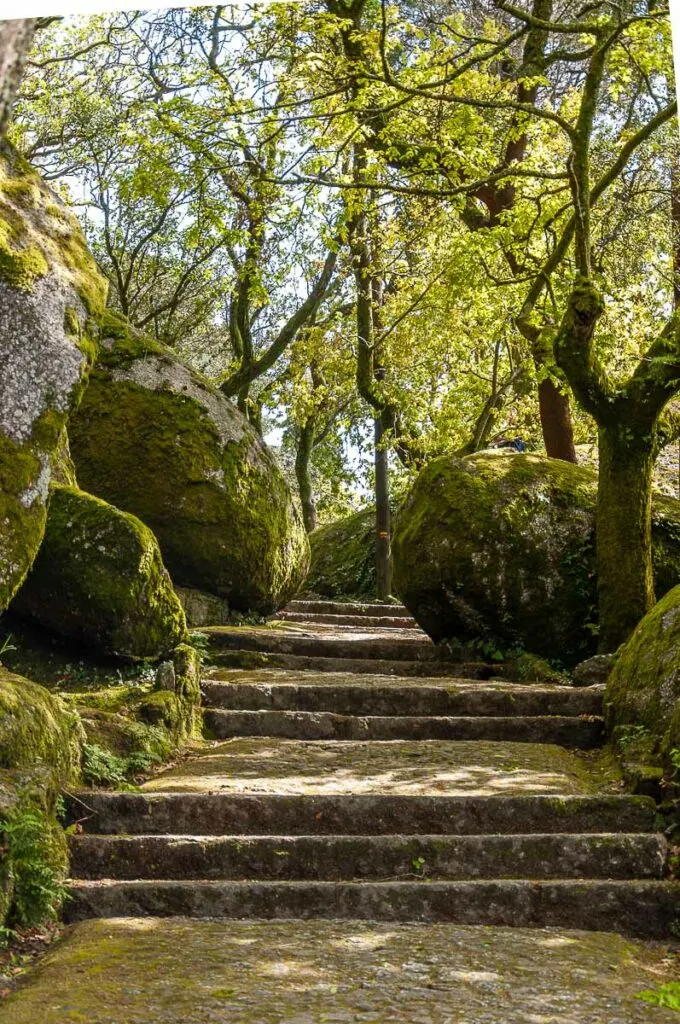
Yet, the city remains a hidden gem that can be explored in one exciting day or, even better, slowly savoured over the course of a long city break.
I have been in love with Guimarães for a very long time. Back in the 1990s, I spent two months there interning at a local radio station. It was an exciting time for me.
I got to know in-depth this small Portuguese city, observed first-hand the locals at their festivals and day to day living, learned about Portugal’s history and traditions, ate local specialities with imaginative names (anyone for a piece of bacon from heaven?!), and mastered my Portuguese nasal diphthongs.

Earlier this month, I had a chance to return to Guimarães once again. As luck would have it, my visit to this must-see Portuguese city coincided with my birthday. It was the best birthday present to spend time once more in such beautiful surroundings.
Contrary to my expectations, I didn’t get a huge wave of memories crashing over me and overwhelming my visit with the nostalgia of times long past (or saudade as they call this unique state of mind in Portuguese).
Instead, I explored the city with the sweet feeling of deja-vu. It was like a place that I knew very well and yet I was visiting for the very first time. I knew which turn to take and the look and feel of the main sights, yet Guimarães felt so exciting to see with new eyes after so many years apart.
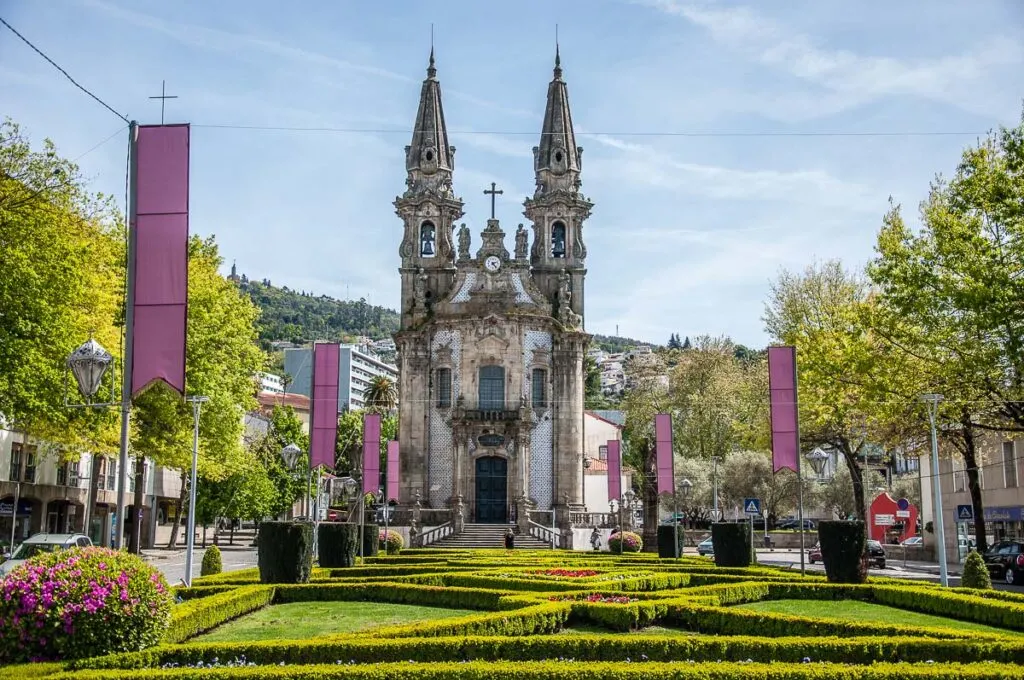
I was so glad to be able to show my husband and my daughter where I had spent two important months of my youth. It was wonderful to revisit the historic centre, to see Guimarães from the top of Monte da Penha, and to eat once again a piece of delicious bacon from heaven or toucinho-do-céu as they actually call it in Portuguese. We had a lot of fun following this one-day itinerary.
Now, I want to share with you this visual travel guide to Guimarães in 17 photos and stories. I hope to entice you to explore this splendid city in Portugal for yourself. Take my invitation and follow my advice. Guimarães is an authentic delight to be discovered and slowly enjoyed.
Here is why!
Visual Travel Guide to Guimarães – 17 Photos That Will Make You Want to Visit the City That Birthed Portugal
Pin for Later!
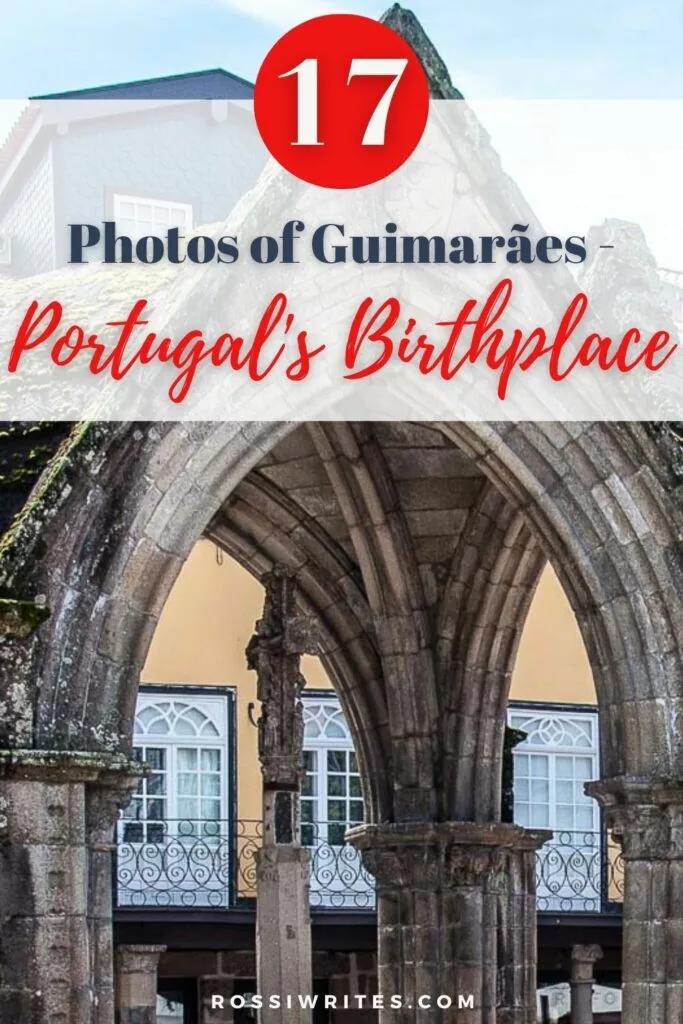
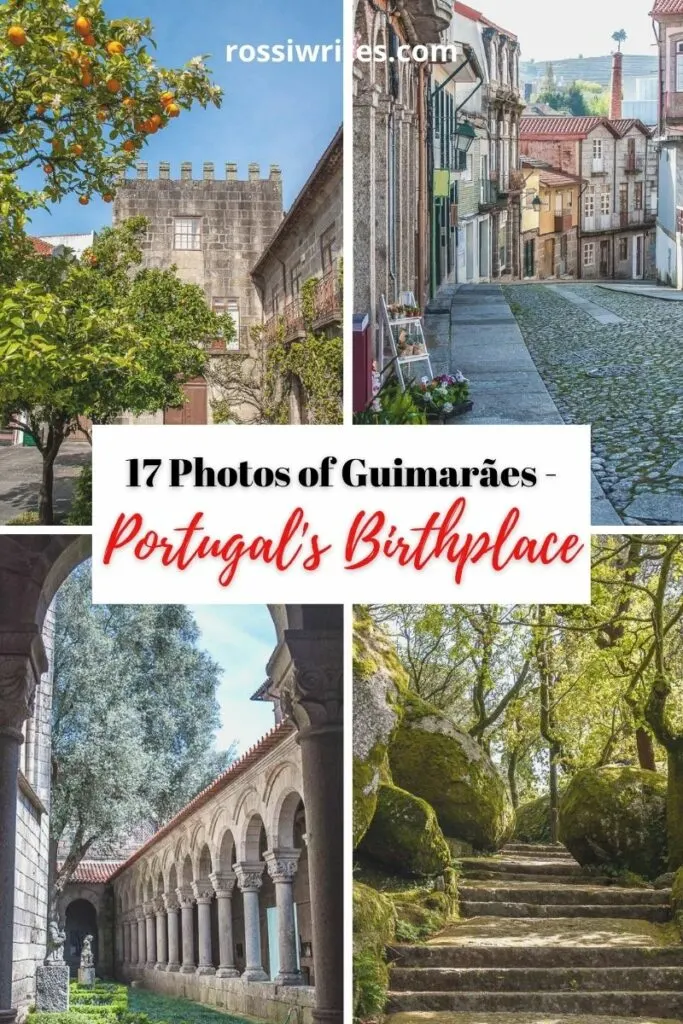
1. Portugal’s Birthplace

It is not in vain that Guimarães is known as the Cidade Berço. In English, this literally means ‘the cradle city’. It was here that Portugal was born as a country and a nation in the first half of the 12th century.
Originally a county ruled by a count and a countess, for several centuries the Condado de Portucale was a vassal of the neighbouring Kingdoms of Asturias, Galicia, and León. However, it strived to become independent and to be recognised as a kingdom itself.
In the process, the aristocratic families of this corner of the Iberian Peninsula – linked by a long line of marriages and complex interpersonal relationships – fought battles and formed alliances. Sisters competed with each other, a cousin defeated a cousin, and strategic weddings were celebrated.
Finally, in 1128 the seminal Battle of São Mamede was fought near Guimarães. In it, a son won against his mother. The mother – Teresa of León – wanted the Condado de Portucale to unite with Galicia. Her son – D. Afonso Henriques – fought for Portugal to become an independent kingdom.
Nowadays, an iconic sign in the centre of Guimarães proudly proclaims Aqui nasceu Portugal – Portugal Was Born Here!
2. The Founder of a Nation
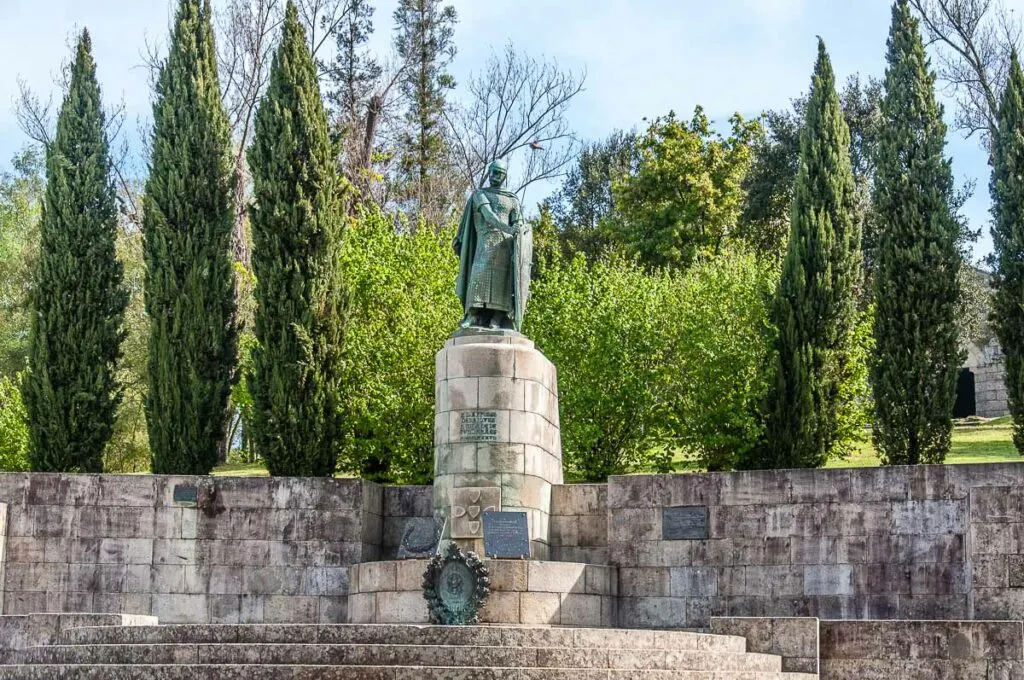
D. Afonso Henriques was Portugal’s first king. Many historians believe that he was born in Guimarães. At the time the city was the most important settlement in the lands of his parents – the Counts of Portucale. After the death of his father Henry of Burgundy, his mother – Teresa of León – proclaimed herself Queen of Portugal and fought for the independence of her lands.
However, swayed by political obstacles and a new Galician lover, she quickly lost sight of her goals. Worried that her son may claim her lands, she sent Afonso away when he was 12. A few years later, he fought against her, proclaimed himself a King of Portugal in 1139, and in 1143 was recognised as such by Pope Innocent II.
Throughout his life, D. Afonso Henriques never stopped. He expanded his kingdom, liberated lands, fought against enemy armies, won decisive battles, and carved out Portugal pretty much as we know it nowadays. Named the Conqueror, the Portuguese still tell legends about him.
Today, his life-size statue stands at the base of the Colina Sagrada – the Sacred Hill – in Guimarães. It was cast in bronze in 1887 by the renowned Portuguese sculptor Antonio Soares dos Reis.
Crowning the hill behind the statue is the medieval Castle of Guimarães which played a decisive role in the Battle of São Mamede. It then served as a base for D. Afonso Henriques and his knights. The hill, the castle, and the small church next to it where they say the Conqueror was baptised as a small child are the most iconic representation of the foundation of Portugal as a country and the Portuguese identity as such.
3. The Heart of the Historic Centre of Guimarães
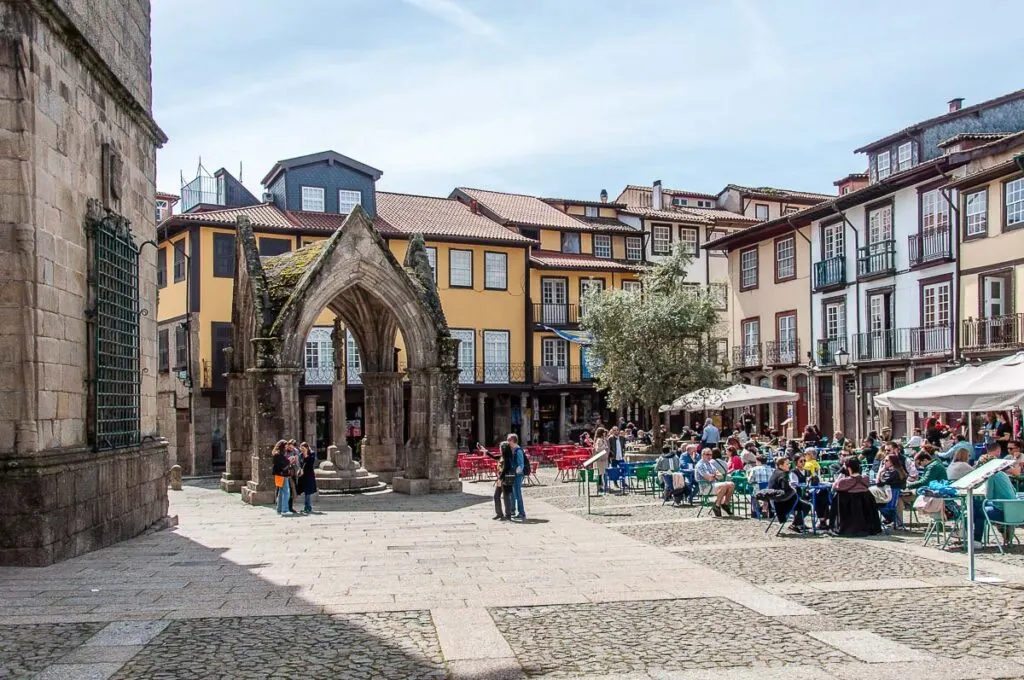
Guimarães has a very pretty historic centre. A small nucleus where many streets and houses date back to medieval times, it’s a pleasure to go for a leisurely walk around it taking in the views and the sounds of the founding city of Portugal.
At the heart of Guimarães’ historic centre stands the iconic Largo da Oliveira – Square of the Olive Tree. There is indeed an olive tree here. Most importantly, this small largo is surrounded by some of the most important historic buildings in Guimarães.
Particularly striking is the Padrão do Salado – a 14th-century arched monument covering a raised cross. It was erected in commemoration of the Battle of Rio Salado in 1340 when the armies of Spain and Portugal stopped the invasion of the Iberian peninsula by the then sultan of Morocco.
Also here you can see Guimarães’ Gothic Church of Our Lady of the Olive Tree (Igreja da Nossa Senhora da Oliveira), the excellent Museu de Alberto Sampaio, and the medieval town hall crowned by a stone sculpture that, they say, represents Guimarães itself.
The square is a very lively place in town and I always gravitated toward it when I lived in Guimarães in the 1990s. During my latest visit to the city in April 2022, I was happy to revisit this beautiful historic spot. It was a fabulous sunny day. People were out and about. We enjoyed a leisurely lunch at one of the many cafes. Sitting at an outside table, it felt so good to be surrounded by so much history and beauty once more.
4. The Picturesque Facades of Guimarães
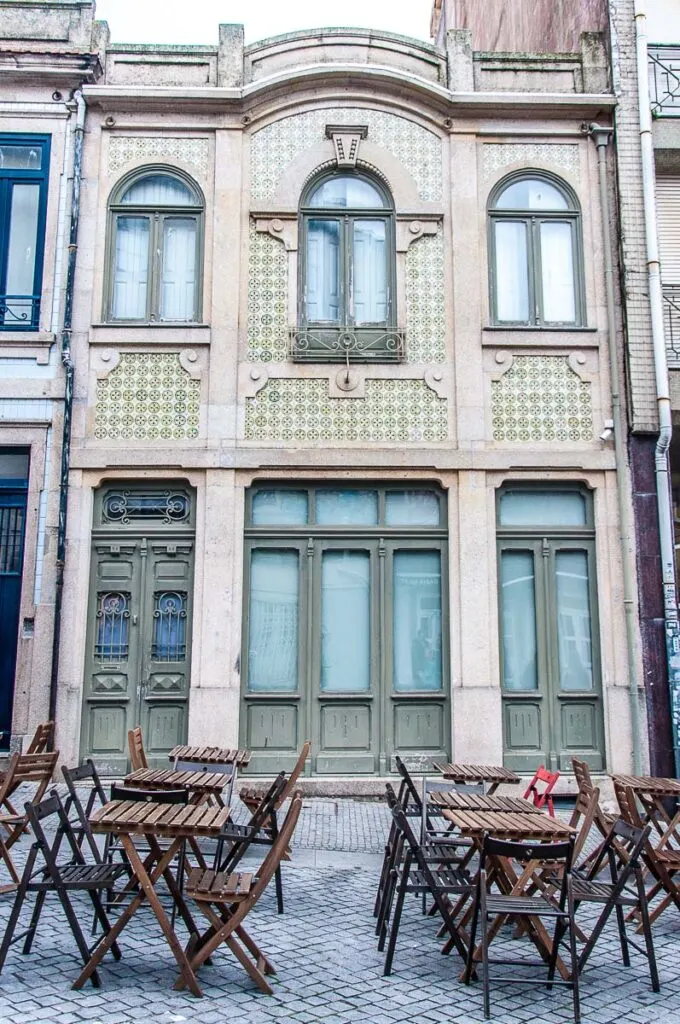
Guimarães has one of the best collections of historic residential facades in all of Europe. It’s a wonderful mix of architectures and decorative elements. From medieval houses with floors of differing heights to symmetrical buildings covered entirely with the famous Portuguese tiles (known as azulejos), you can trace the evolution of styles and see how structures adapted to changing needs.
Guimarães was inscribed by UNESCO in 2001. The city’s historic centre became a World Heritage Site specifically for being a ‘well-preserved and authentic example of the evolution of a medieval settlement into a modern town’.
Strolling around Guimarães you will see many unique houses that are so easy to fall in love with. The above photo was the last I took in the historic centre before we had to rush to the railway station for our train back to Porto. It shows one of the many unique houses in Guimarães that, nevertheless, create a lovely cohesive blend standing next to one another in the historic nucleus.
I particularly love the green azulejos, the elegantly arched windows of the upper floor, and the gentle curve of the central panel of the facade.
5. The Traditional Shops of Guimarães
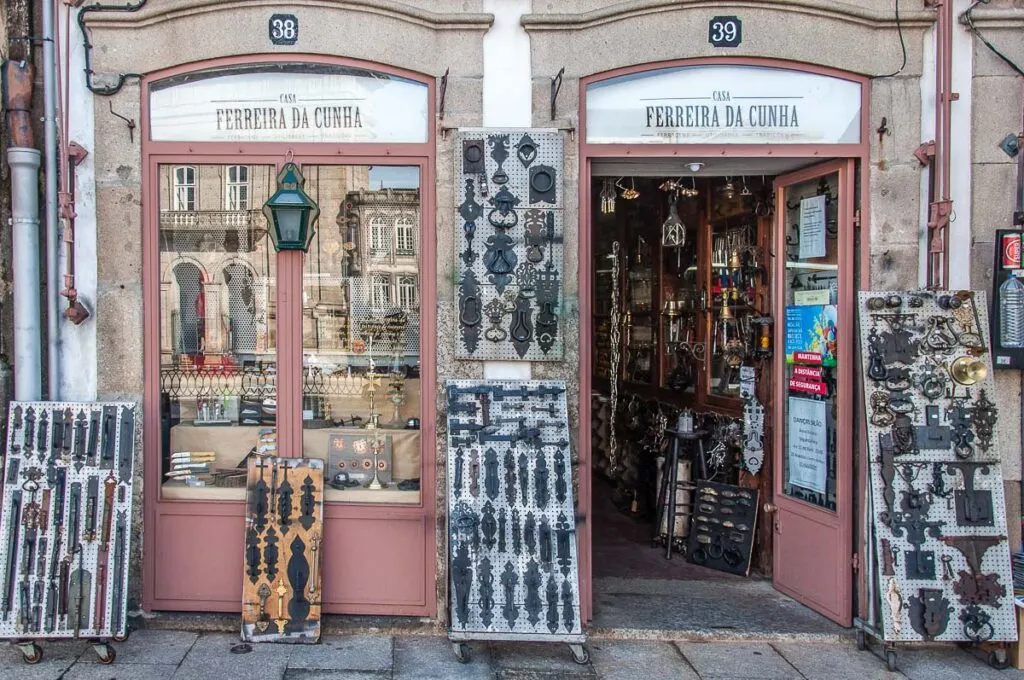
What I love about Portugal is the preservation of small, traditional, family-owned shops. They are such a joy to explore as they are full of treasures that are difficult to come across in the identikit high streets dominated by large multinational chains.
Guimarães has its share of small shops. Popping in and out of them as you walk around the historic centre adds yet another dimension to the pleasant exploration of Portugal’s birthplace.
You will find this small hardware shop at Guimarães’ elegant main square – Largo do Toural. Founded in 1922, the shop – or Casa Ferreira da Cunha as it’s known – is exactly one hundred years old!
Looking at its wares, I wished I had a big quirky house to renovate so that I could buy artisanal wrought-iron handles and latches to use. Maybe one day! What a great excuse it would be then to return to Guimarães once again.
6. The Town Hall of Guimarães
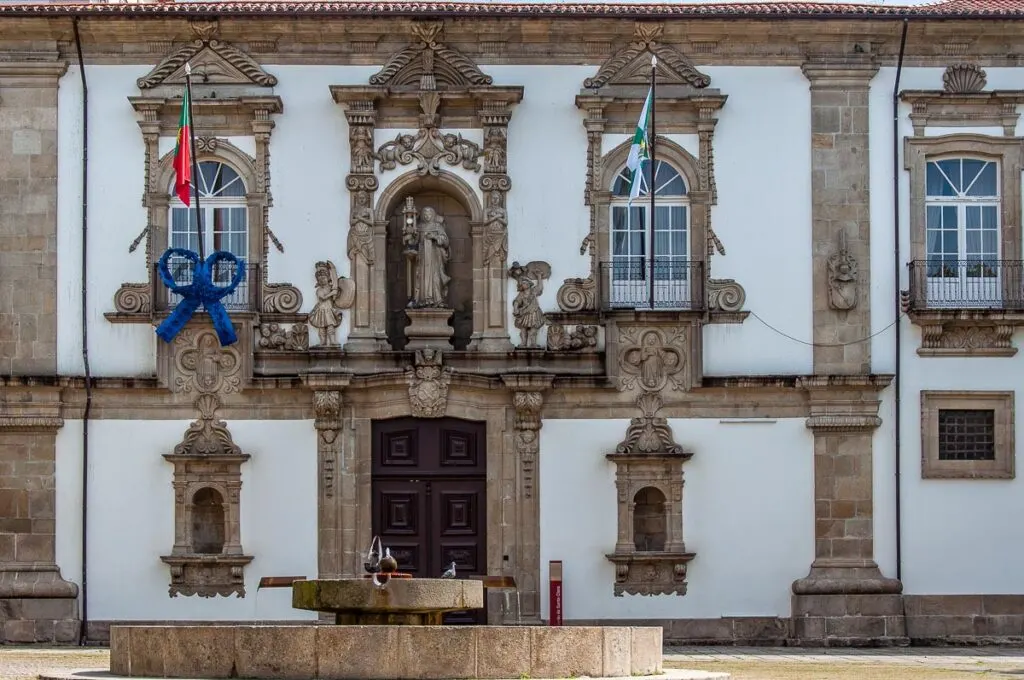
This is Guimarães’ Town Hall. It was originally, a convent dedicated to St. Clare (or Santa Clara in Portuguese). Founded in the 16th century, the convent grew to be one of the richest in the area and its church was lavishly adorned with gilded wood carvings. Nowadays, a large part of them is preserved in the Museu de Alberto Sampaio a short walk away.
The richly decorated Baroque facade was erected in 1741. In the central niche, you can see a statue of St. Clare – one of the first followers of St. Francis of Assisi and the first woman to write a set of guidelines for monastic life. I found most curious the two figures of soldiers flanking the niche of the Saint. If you look closely, you will notice that they hold large scimitars.
The Convent of Santa Clara in Guimarães was disbanded in 1834 after the dissolution of the religious orders in Portugal. Nowadays, it houses the Town Hall and the local archives. In front of the building, there is a small, sunlit square with a circular fountain. It’s a nice place to stop for a short break during your walk around the city.
While the convent doesn’t exist any longer, it has bequeathed to Guimarães one of the city’s greatest treasures: its traditional sweets and desserts. The egg-rich recipes were developed by the nuns over many decades. Nowadays they are a closely guarded secret of a handful of local families. To this day they make by hand the delicious toucinho-do-céu, tortas de Guimarães, and douradinhas de Guimarães you can enjoy in selected patisseries in town.
7. The Divine Toucinho-do-Céu

This is Guimarães’ famous delicacy – the toucinho-do-céu. At a first glance, it looks a bit like a meatball that you have just rolled in the palms of your hands and patted flat just a bit to give it its final shape.
The toucinho-do-céu is then rolled in copious amounts of flour. However, it doesn’t get fried. Frying wouldn’t do anything for it as its main ingredients are ground almonds, sugar, and almost two dozen egg yolks!
The result is a dense, rich paste that’s chewy in an inexplicably nice and satisfying way and hits a sensory spot that you didn’t even know you had. It’s not surprising then that this unusual concoction – created centuries ago by the nuns of the Convent of Santa Clara in Guimarães – is known as toucinho-do-céu or, as it’s usually translated in English, bacon from heaven.
You may find many recipes for toucinho-do-céu online. The one for the Guimarães variety, however, is secret and has one very unusual ingredient – the fibrous strands of chila.
In English, chila is fig leaf gourd – a type of squash. It’s oval in shape, has pleasing green colour, and in size resembles a medium melon. Its fibrous pulp is what gives Guimarães’ toucinho-do-céu its inimitable chewy texture.
8. The Courtyard of the Museu de Alberto Sampaio
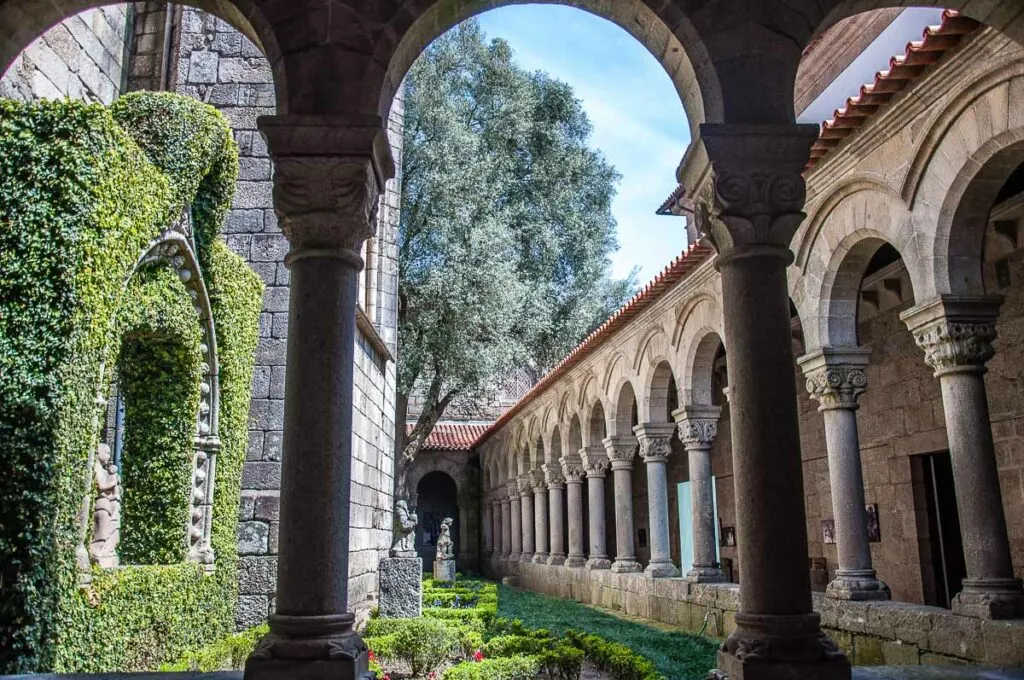
The Alberto Sampaio Museum is one of the main landmarks in Guimarães. It borders the historic square Largo da Oliveira. Founded in 1928, it’s housed in three spaces – Chapter House, Cloister, and Priory – that once belonged to the adjacent Church of Nossa Senhora da Oliveira.
It’s not surprising then that the premises of the museum are almost as interesting as the rich collections of artefacts that they host. The cloister with its lush shrubs is especially beautiful.
Inside, the museum has eight rooms and several thematic clusters with objects dating from the 12th to the 19th centuries. From jewellery and textiles to gilded wood carvings, frescoes, paintings, and sculptures, you can explore the best expressions of art that once decorated the convents and some of the churches in Guimarães.
One of the highlights of the Museu de Alberto Sampaio is the room dedicated to the Battle of Aljubarrota. It was fought in the 14th century between the Kingdom of Portugal and the Crown of Castille. The Portuguese King D. João I emerged victorious and offered his thanks to Santa Maria of Guimarães (nowadays venerated as Our Lady of the Olive Tree).
The most curious thing about the museum, however, is that it stands at the spot where a large monastery was founded in the first half of the 10th century thus giving rise to Guimarães as a settlement.
The monastery was built on the orders of Mumadona Dias – a Countess of Portugal and the richest and most powerful woman in this corner of the Iberian Peninsula at the time.
By the way, Mumadona (and what a great name!) also ordered the construction of the Castle of Guimarães. This is the same castle that two centuries later D. Afonso Henriques would use when he founded the Kingdom of Portugal.
9. The Charming Square of the Orange Trees
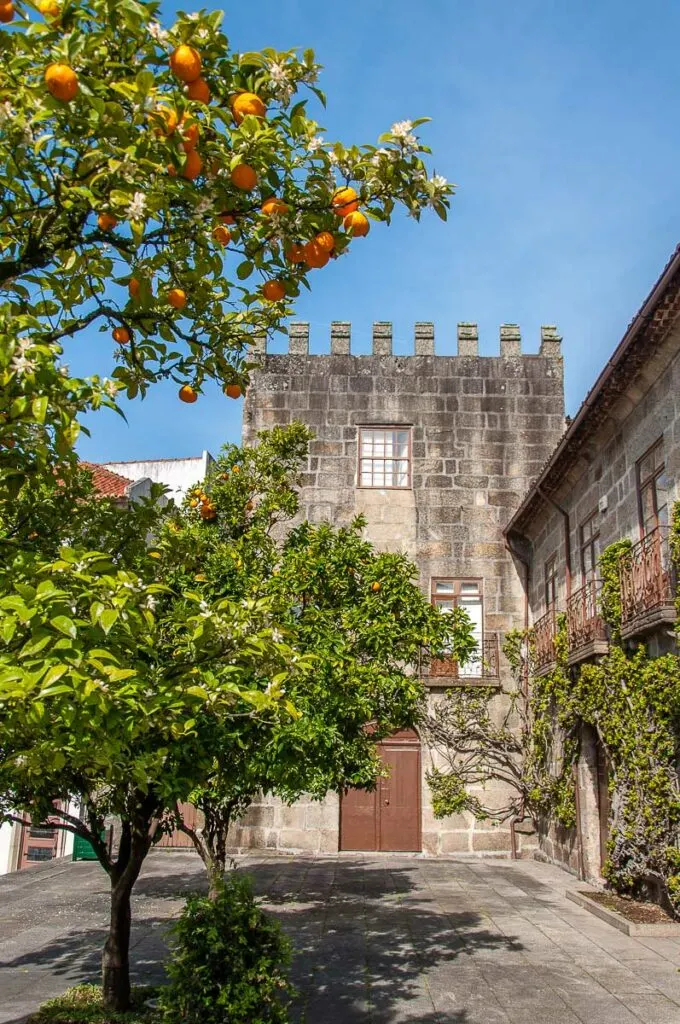
Although small and compact, Guimarães has many hidden corners that are full of history and charm.
Largo dos Laranjais – the Square of the Orange Trees – is one such spot. This small square is paved with flat stone slabs. A proud medieval tower stands above the orange trees. It’s picture-perfect!
In spring, the trees are abundantly covered with blossoms attracting both bees and visitors of Guimarães like me with their heady, delicious fragrance.
Curiously enough, although blossoming, the orange trees in Guimarães also carried a heavy load of ripe fruit. Apparently, as they are evergreen they can produce fruit year-round as long as the climate allows it.
By the way, in Bulgarian, Greek and Turkish the word for the fruit of the orange tree is respectively портокал (pronounced portokal), πορτοκάλι (pronounced portokali), and portakal. Oranges, they say, reached Europe via Portuguese traders, so in several languages, they became synonymous with the country itself.
10. The Beautiful Balconies of Guimarães
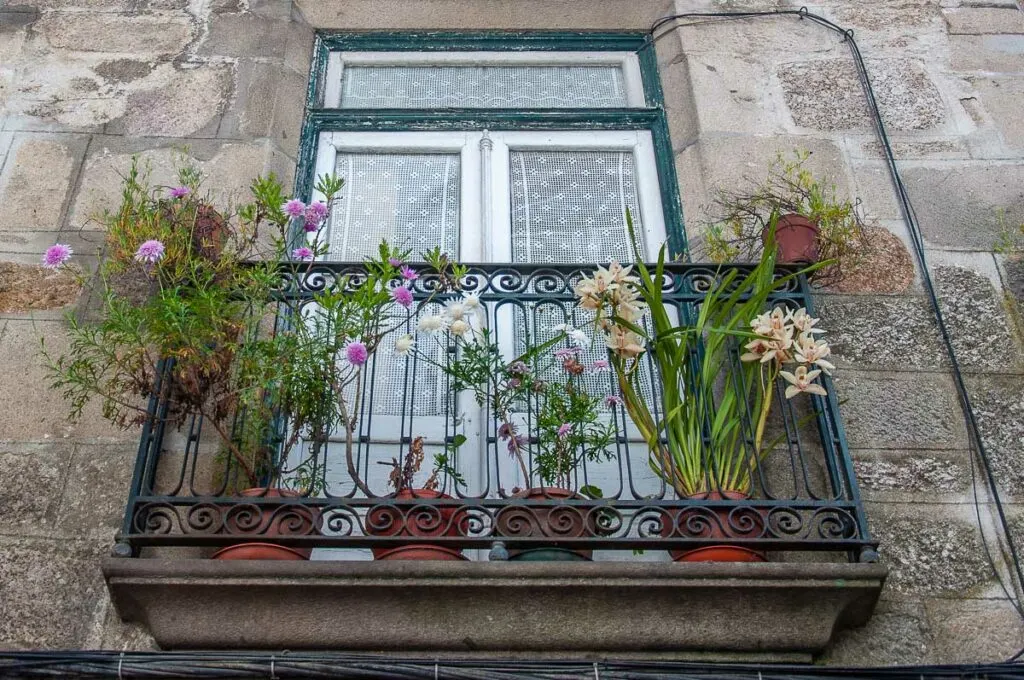
Blossoms in Guimarães are not limited to the Largo dos Laranjais. Everywhere I looked around town, I noticed small balconies affixed to historic facades and decorated with blooming potted flowers.
This made the city look so pretty, so loved, and so well taken care of. While nearby Porto – Portugal’s second-largest city – is rich in balconies but poor in potted plants, Guimarães has both in generous supply. And I loved it!
I walked around the historic centre, head tilted back on a visual hunt for picturesque balconies and terraces decorated with pots and plants. I was in for a real treat.
‘You know!’, I told my husband at the end of the day, ‘if, when we retire, we end up living in a small house with a small balcony with wrought-iron railings and dozens of potted plants, this would have been a life well worth living!’.
11. The Historic Churches of Guimarães
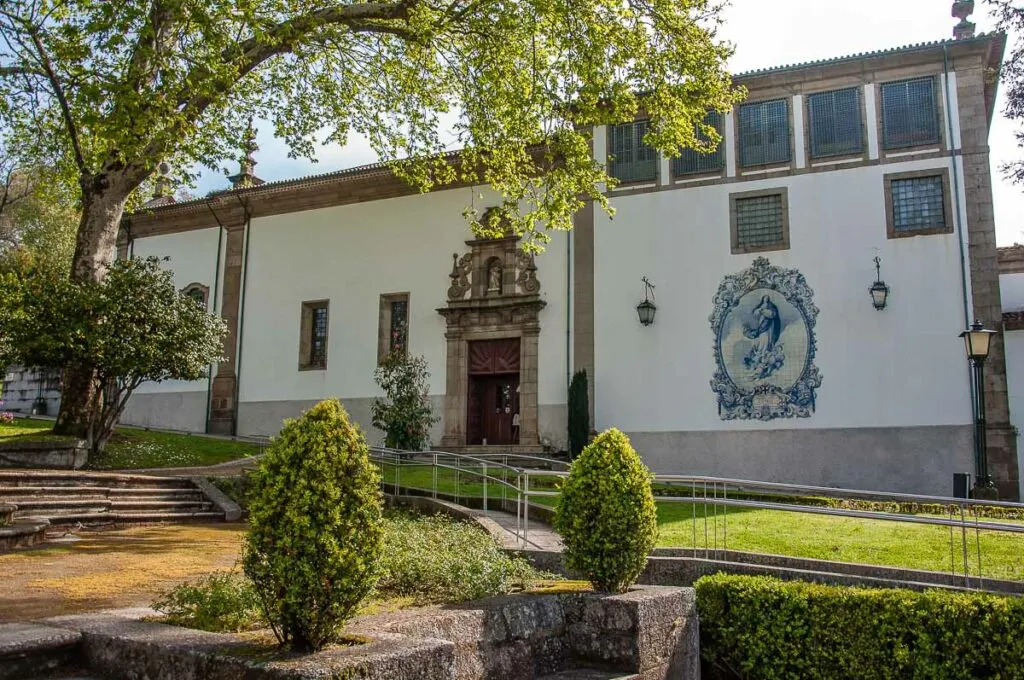
Just like every city, town, and village in Portugal, Guimarães is dotted with a large number of churches. The religiosity of the Portuguese is something to behold. They do believe! Not just in God, but in so many different saints, miracles, divine events, heavenly protections, and beatific inspirations.
Faith is an integral part of the fabric of their being.
While, from the point of view of art, I still prefer the churches of Italy to those of Portugal, I still very much enjoyed visiting several chapels, sanctuaries, convents, and cathedrals during my week-long break in the north of the country.
In Guimarães, I loved seeing the small Church of Nossa Senhora do Carmo (Our Lady of Mount Carmel). It flanks a lovely green garden with a circular water feature. It’s on the way to the iconic Colina Sagrada. On a hot sunny day, it must be so nice to sit in the garden for a little bit while listening to the trickle of water and contemplating the church’s white facade and its azulejo panel.
12. Guimarães Seen from the Top of Monte da Penha
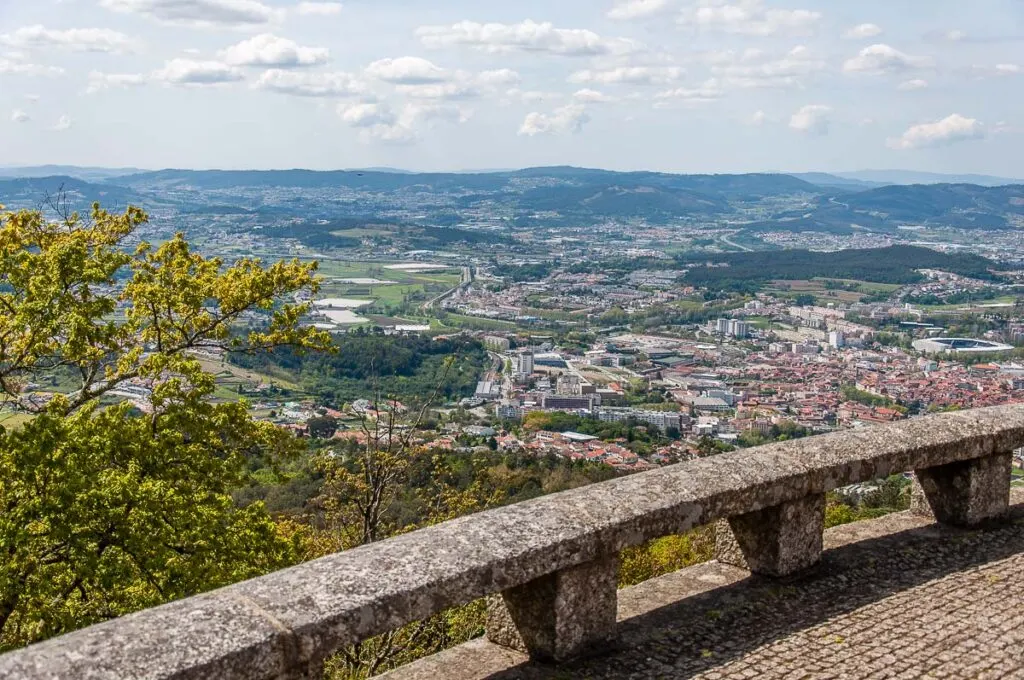
Penha is a small mountain backing onto the valley at the flat bottom of which Guimarães spreads out. It’s called a mountain but Penha is more like a tall hill. 613 m tall, precisely.
The locals go there to hike, camp, picnic, and enjoy the views. You can imagine that thousands of years ago, when the first people to populate the area of Guimarães settled on the mountain of Penha, they did more or less the same.
Archaeological excavations have revealed proof of their prehistoric lives. The artefacts are in Guimarães’ Archaeological Museum and some are shown inside a small glass display in the top station of the Penha Mountain cable car.
Taking the cable car is a great idea when in Guimarães. It whisks you up to the top of the mountain in no time at all. Otherwise, you can drive up there, as many of the locals do.
The panoramic views from the top are really worth it! On a clear day, the eye travels far across the valley and to the lush hills brimming the horizon. And then, if you focus your gaze on the ant-size houses of Guimarães down below, you will soon notice the city’s medieval castle and, just a few steps away from it, the other sizeable gem in the city’s crown – the 15th-century Palace of the Dukes of Bragança.
Otherwise, the Penha Mountain (or Monte da Penha as it’s known in Portuguese) has its own landmark – the Penha Sanctuary. Built between the 1930s and the 1940s, its church is striking.
It doesn’t have a florid Baroque facade like so many churches all over Portugal. It’s not covered in azulejos either. Instead, the Penha Sanctuary is rather angular, bare-boned, and it seems to grow straight from the rocks. Its dark grey colour matches quite well the huge boulders that – covered with moss – lay haphazardly around and give this natural landscape a fairytale feeling.
13. The Thousand Years Old Street
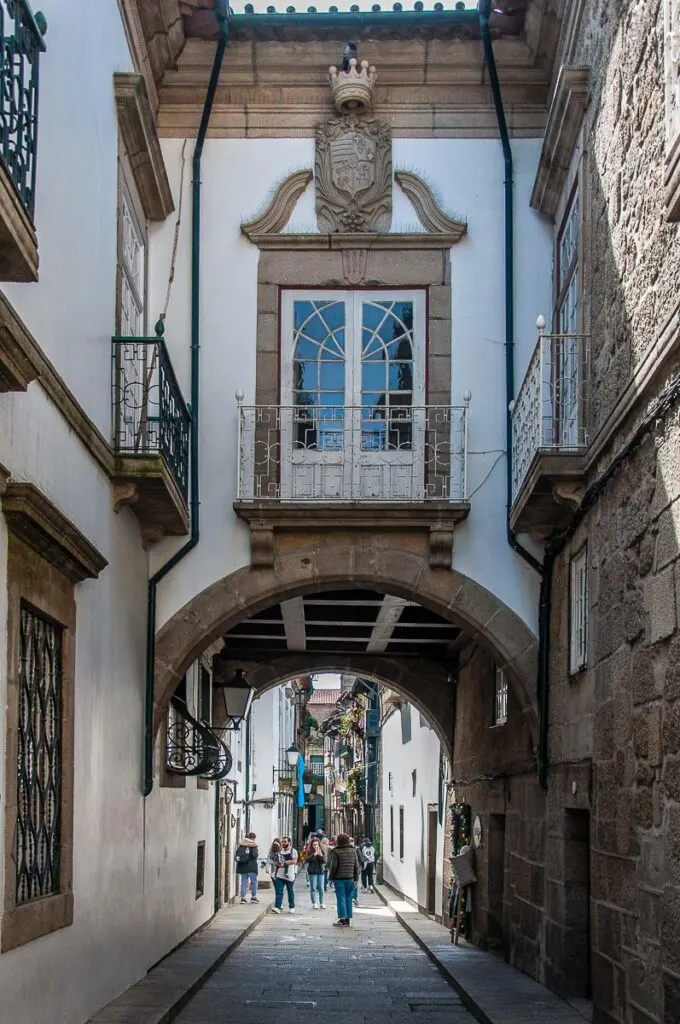
Rua de Santa Maria in the historic centre of Guimarães is one very special street indeed. It was first laid out many centuries ago. Some say it’s been over a thousand years since it was first walked on. At the time, it connected the then still new Castle of Guimarães and the small settlement just down the hill from it.
The settlement had grown around the monastery set up in the 10th century by the formidable and powerful Lady Mumadona – the then Countess of the Condado de Portucale.
In the centuries that followed, the settlement grew into what we nowadays know as the Portuguese city of Guimarães. It expanded further beyond its original confines. And the Rua de Santa Maria remained at its heart, still leading from the base of the Colina Sagrada down into the historic centre’s main squares – Praça de São Tiago and Largo da Oliveira.
Nowadays, historic landmarks (like the Convent of Santa Clara), tall houses, and quirky shops line up the Rua de Santa Maria. The street is one of the most photogenic spots in town. Walking it from start to end is following in the steps of history and all those people who have traversed Guimarães and influenced in one way or another its destiny.
14. Palm Sunday in Guimarães
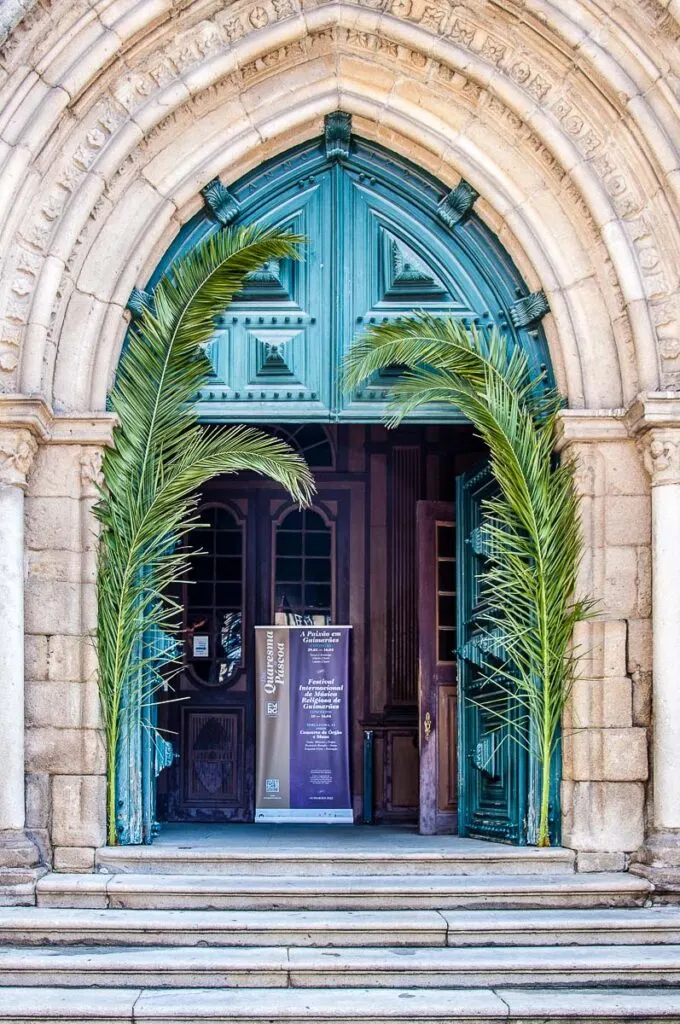
We were in Guimarães on the Saturday before Palm Sunday. Fittingly, huge palm leaves had been used to decorate churches and chapels all over Portugal. Their lush green colour gave a new lease of life to centuries-old pillars, windows, and doors.
With the Holy Week about to start, you could feel the forthcoming celebrations in the air. Longheld traditions were to be upheld once more.
This is the main entrance of Guimarães’ historic Church of Nossa Senhora da Oliveira. It stands at the corner of the Largo da Oliveira and right next door to the Museu de Alberto Sampaio.
Make sure that you visit this church when in town. No matter the day – a holiday or a weekday – it offers a quiet moment in time and the opportunity to immerse yourself in the space where the people of Guimarães have offered for centuries their heartfelt prayers.
15. The Colours of Light
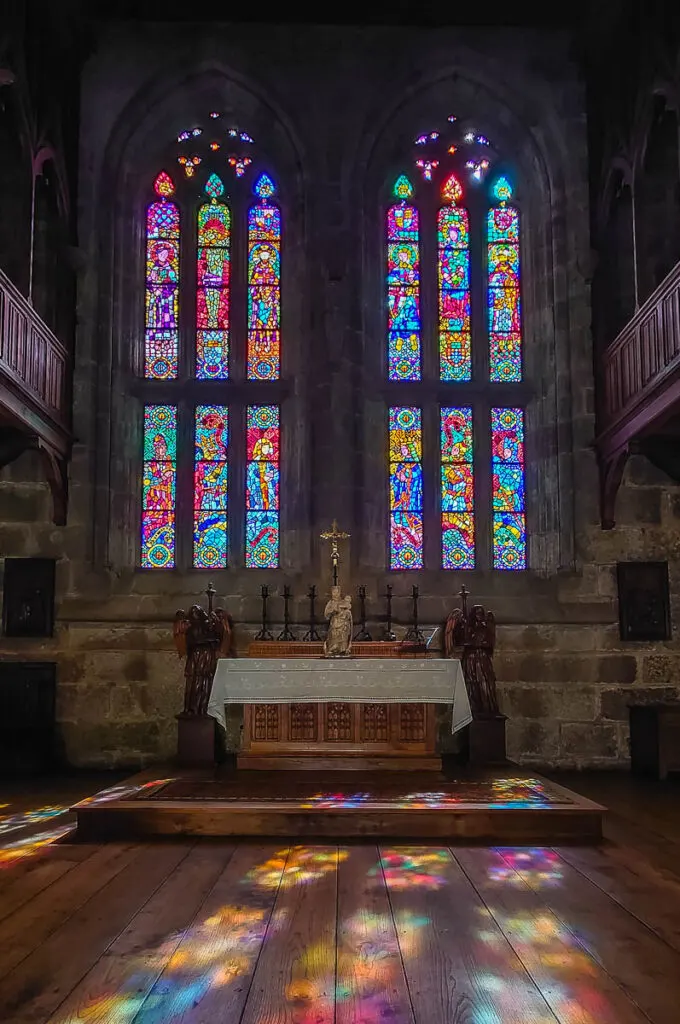
This is the Palatine Chapel in the Palace of the Dukes of Bragança. Known as Paço dos Duques de Bragança in Portuguese, this is the second top sight in Guimarães after the city’s medieval castle.
The two – castle and palace – stand almost side by side on the Colina Sagrada. Between them is only the tiny Romanesque Church of São Miguel do Castelo where, the legend says, D. Afonso Henriques – the founder of Portugal – was baptised in his infancy.
The palace was originally built at the start of the 15th century by Afonso de Barcelos – the illegitimate son of King João I of Portugal. It’s a large rectangular building that has much suffered throughout the centuries. Abandoned and semi-ruined for a large part of its existence, nowadays, it has been restored to its former glory and then some.
The palace’s chapel today is a visual representation of what a traditional 15th-century chapel would have looked like. The large stained glass windows depict divine and real-life figures – from Jesus Christ and Our Lady of Guimarães to different saints, the founder of Portugal, and other distinguished Portuguese royals.
Curiously enough, among them all stands Philippa of Lancaster (or Dona Filipa de Lencastre as the Portuguese call her). An English royal, she married the Portuguese King D. João I giving him numerous children who became known as the Illustrious Generation of rulers of the country.
I loved the colourful shadows produced on the floor of the Palatine Chapel by the sun rays streaming through the large stained glass windows. It was a beautiful vibrant splash in the otherwise quite austere palace.
16. The Austere Grandeur of Guimarães
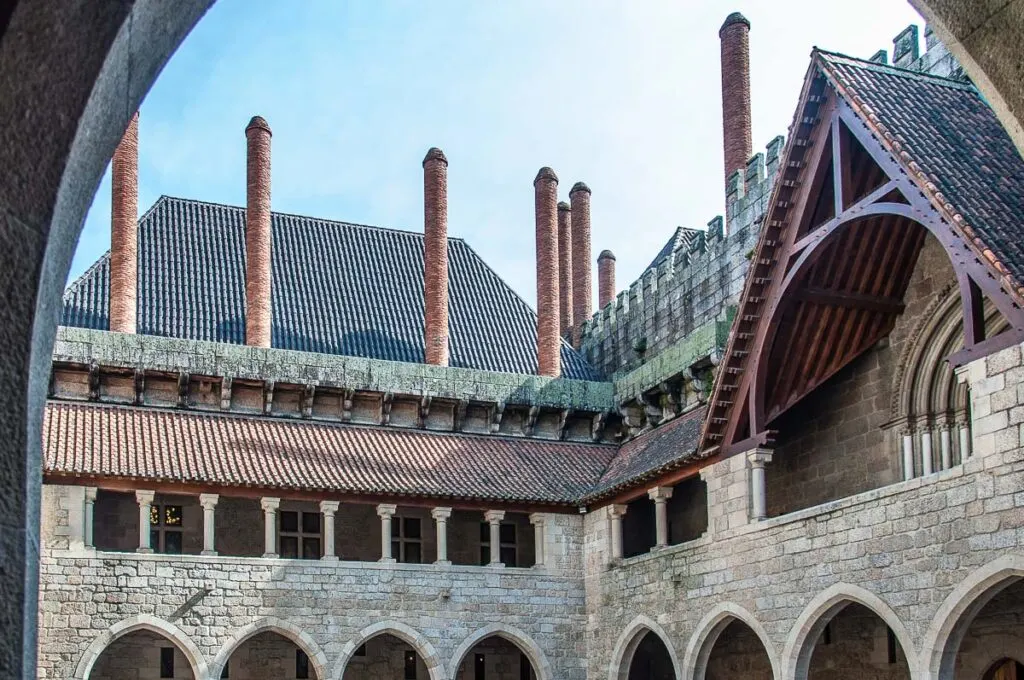
This is a view of the courtyard of the Palace of the Dukes of Bragança in Guimarães, Portugal. As you can see it’s a rather austere building with strict geometric lines. On the outside, only the numerous tall chimneys seem to add a little touch of whimsicality to the palace.
Inside, the enormous halls have been decorated over the last century with pieces of historic furniture. Particularly interesting to me were the huge Flemish and French tapestries covering some of the walls.
Yet, the scale of the rooms is such that – in spite of the long tables and heavy chairs carefully positioned in them – they still seem quite bare. I actually quite liked that as it allows the eye to take in the huge scale of the construction rather than getting lost in thousands of little fripperies and details.
While the palace was mostly abandoned between the 16th and the 19th centuries, it was completely renovated and restructured from 1937 to 1959.
It’s interesting to note that the Paço dos Duques de Bragança is the official residence of the President of Portugal in the north of the country. As such, in the past it was also used by António de Oliveira Salazar – the prime minister and dictator of Portugal who between 1932 and 1968 established one of the longest-standing authoritarian regimes in Europe.
17. The Beginning of Portugal
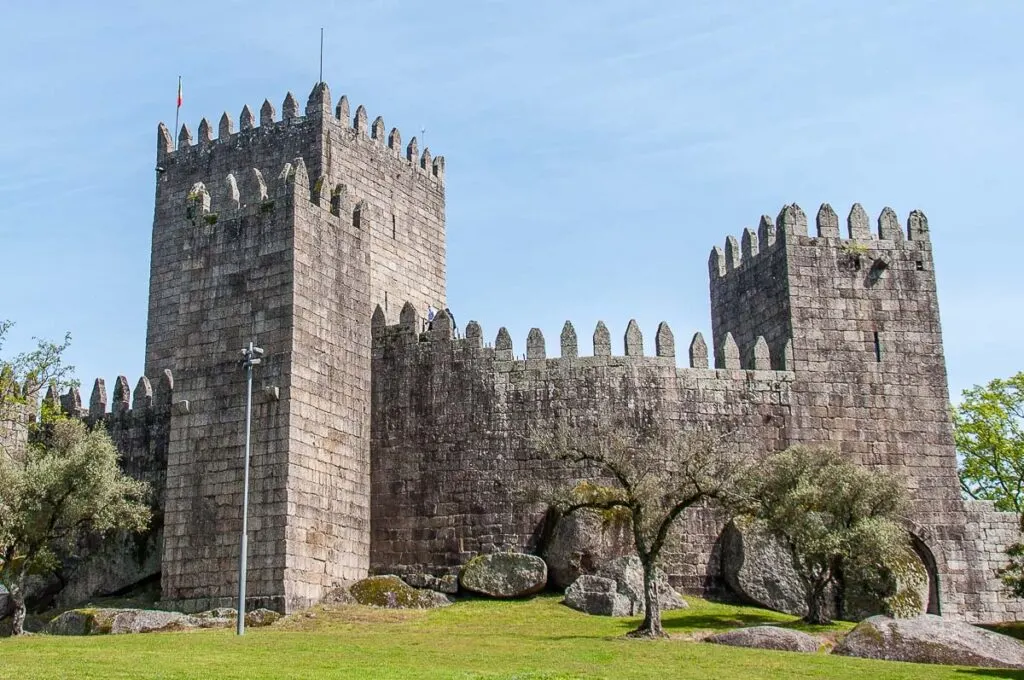
Here it is! The Castle of Guimarães! The beginning of Portugal as an independent country. Small yet sturdy, humble yet glorious. More than a castle, it has become a symbol for the whole nation.
A must-see when you are in this beautiful city in the north of Portugal, the castle doesn’t take long to explore. Its donjon houses a small display of informational boards. A walkway takes you along the top of its crenellated defensive walls. And that’s it. More or less.
Yet, it feels very special being up there, looking out at the Palace of the Dukes of Bragança and then further down to the historic centre of Guimarães. Objectively speaking it’s a small castle on top of a small hill. However, it gave rise to great ambitions and achievements that made history.
In Conclusion
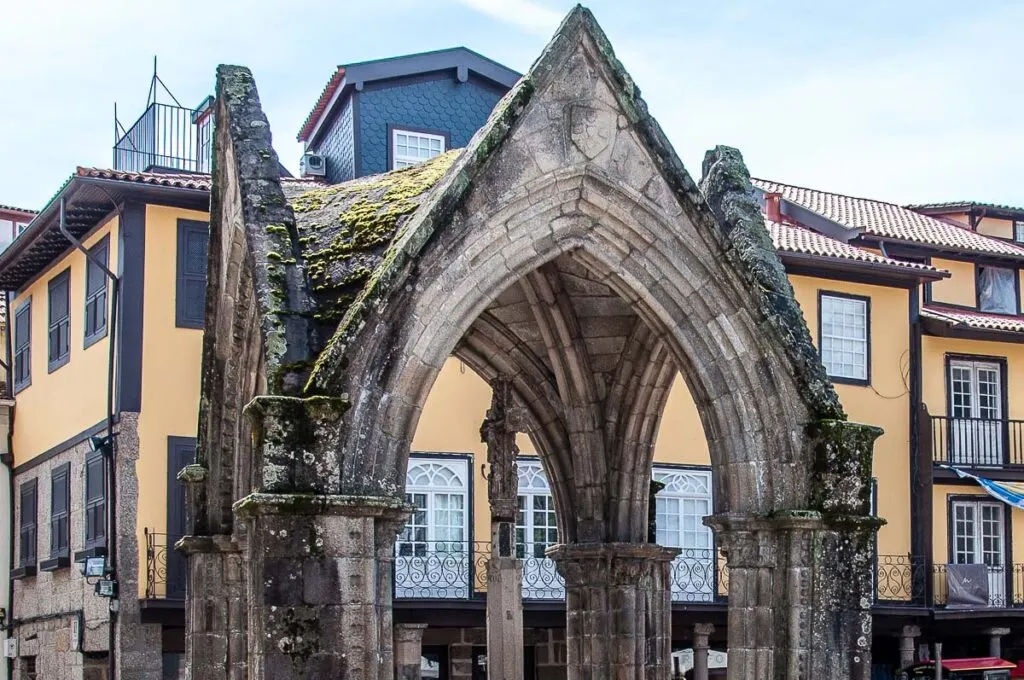
I hope that you enjoyed this walk in photos through the history and the sights of Guimarães. Nowadays a small city near the northern Portuguese-Spanish border, this was the place where Portugal was officially born as a country in the first half of the 12th century.
Once ruled by powerful personalities and nurturing convents with a rich heritage, today, Guimarães is a hub of colourful festivals, cultural events, and delicious desserts. Stretching at the bottom of a small valley, the city is surrounded by gently-sloping hills offering beautiful panoramic views and so many chances to keep active.
Easy to reach from Porto – Portugal’s second-largest city – both by road and railway, Guimarães is a wonderful day trip or a city break destination in the north of the country. If you are looking for a new place to explore, I hope that this visual travel guide to Guimarães has caught your eye and galvanised you to see this Portuguese city for yourself.
All the photos of Guimarães in this blog post were taken by me during my most recent visit. It’s a beautiful place that I love, so I hope that the images and the information shared on this page will come in very useful during the planning stages of your Portuguese holiday.
Have a great time in Portugal!
And enjoy discovering Guimarães!
Now, get ready quick for your visit to Guimarães, Portugal!
- Consult these guidebooks.
- Buy plane tickets.
- Book train tickets, bus tickets or rent a car.
- Research accommodation.
- Select local tours and activities.
More Helpful Travel Info for You
Best of Portugal: One Day in Guimarães, One Day in Porto, Photos of Porto, One Day in Aveiro, Photos of Aveiro, Photos of Braga, Sanctuary of Bom Jesus do Monte, Best Portuguese Desserts and Pastries
Best of Italy: Venice, Lake Garda, Veneto, Lombardy, Emilia-Romagna, Marche, Friuli Venezia Giulia, Trentino, Italy with Kids, Italy for Foodies, Day Trips in Italy, Hiking in Italy, Christmas in Italy
Best of England: London, Kent, Dorset, East Sussex, Days Out in England
Travel: Travel Resources, The Joy of Travel, Safety Tips
Thank you for reading! Please, leave me a comment, pin the images or use the buttons right at the top and at the end of this blog post to share it on social media.
For more useful information like this, please, like my blog’s page on Facebook and subscribe to my strictly no-spam newsletter.
Pin This Blog Post!


